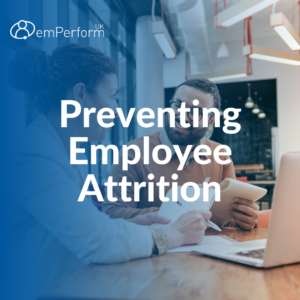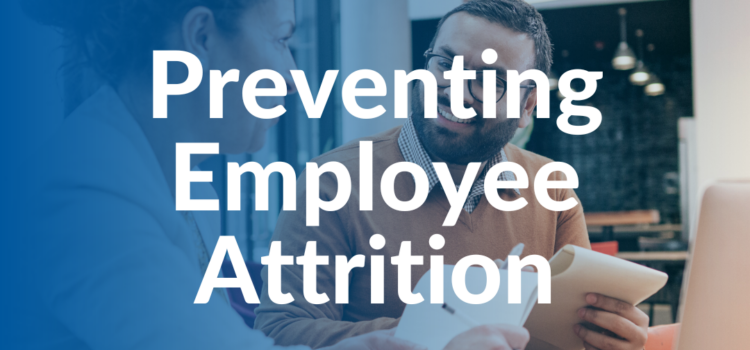 Employee attrition can pose significant challenges for organisations of all sizes. Not only does it disrupt workflow and team dynamics, but it also incurs substantial costs associated with recruitment, training, and lost productivity. In today’s competitive job market, where skilled professionals have ample opportunities, retaining top talent has become a priority for forward-thinking companies.
Employee attrition can pose significant challenges for organisations of all sizes. Not only does it disrupt workflow and team dynamics, but it also incurs substantial costs associated with recruitment, training, and lost productivity. In today’s competitive job market, where skilled professionals have ample opportunities, retaining top talent has become a priority for forward-thinking companies.
In this blog, we delve into effective strategies for preventing employee attrition and fostering a workplace environment that encourages loyalty and longevity. From understanding the root causes of turnover to implementing targeted retention initiatives, we will explore practical approaches to help organisations retain their valuable talent and build a resilient workforce.
What is Employee Attrition
Employee attrition refers to the natural process of employees leaving the workforce for various reasons, such as retirement, resignation, termination, or transferring to another company. It is the rate at which employees leave a workforce over a certain period. Attrition can be voluntary, when employees leave of their own accord, or involuntary, when they are terminated.
Elevated levels of employee attrition can be costly for organisations, as they may incur expenses related to recruiting, hiring, and training new employees to replace those who have left. Additionally, attrition can also impact team dynamics, productivity, and morale, especially if key employees leave unexpectedly.
Understanding the reasons behind attrition and implementing strategies to mitigate it, such as improving employee satisfaction, offering competitive benefits, providing opportunities for career growth, and fostering a positive work environment, can help organisations reduce turnover and retain valuable talent.
Causes of Employee Attrition
Insufficient Progression Opportunities
According to Gallup, organisations that strategically invest in employee development report an 11% increase in profitability and are twice as likely to retain their employees. By prioritising development initiatives, employers show their commitment to their employees’ growth, resulting in improved retention rates and decreased turnover costs. Explore our blog post on leveraging mentoring for employee development for more insights.
Negative Workplace Culture
Research conducted by the CIPD reveals compelling insights into the impact of workplace culture on organisational outcomes. Organisations fostering a positive workplace culture experience a notable 12% surge in employee engagement, along with a remarkable 21% increase in profitability. Additionally, they also benefit from a significant 10% reduction in employee turnover rates. These discoveries highlight the significance of placing emphasis on the well-being of employees and cultivating a supportive environment. By nurturing a positive culture within the workplace, companies not only boost employee morale and contentment but also foster increased levels of involvement. This elevated engagement, consequently, leads to enhanced productivity and innovation, thereby driving greater levels of profitability.
Inadequate Work-Life Balance
Integrating work-life balance policies into organisational practices yields multifaceted benefits. Notably, these policies contribute to significant reductions in turnover rates, absenteeism, and healthcare expenses, thereby positively impacting the bottom line. According to a study conducted by the CIPD, companies that prioritise supportive work-life balance policies enjoy a substantial 25% decrease in absenteeism rates.
This finding underscores the tangible advantages of fostering a workplace environment that prioritises employee well-being and acknowledges the importance of achieving a healthy work-life balance. By implementing policies that accommodate employees’ personal and professional needs, organisations demonstrate their commitment to promoting a culture of holistic support and flexibility. Consequently, employees are more likely to feel valued, motivated, and engaged, leading to enhanced job satisfaction and overall performance.
Poor Job Satisfaction & Pay
Job satisfaction often correlates closely with compensation. While employee contentment encompasses more than just salary, competitive pay is often a fundamental factor in fostering workplace happiness. For numerous individuals, their pay hasn’t matched the pace of inflation or their personal aspirations, if not both. Compensation isn’t solely the sum an employee pockets monthly; it encompasses bonuses, yearly raises, and other monetary benefits. Together, these elements foster financial stability, a crucial component of overall financial health. Put simply, an employee won’t stay with a company if they are not being paid a fair wage, especially if another company offers them more.
Attrition vs. Turnover
Employee turnover is commonly misunderstood as simply the number of employees who leave an organisation within a given year. However, a more precise definition of turnover involves the rate at which a company replenishes its workforce over a specific period.
Turnover should only account for positions that become vacant and are subsequently filled. If an employee departs and their role remains unfilled, this situation reflects either attrition or a deliberate downsizing of the workforce. Therefore, turnover calculations should focus solely on the positions that are vacated and then replaced.
How to Calculate Attrition

How to Improve a High Attrition Rate
Offer Training & Development Programmes
Ensuring employees are adequately equipped with the requisite knowledge, skills, and tools is indispensable for organisations. This can be accomplished by offering comprehensive training and resources customised to their role. Through investment in training programs, workshops, or online materials, both employees and employers can establish clear expectations and address potential challenges proactively. The level of effort dedicated to training new employees directly correlates with their learning pace and effectiveness as workers. When employees receive sufficient training and possess the necessary tools to succeed in their roles, they are more inclined to remain with the company and excel in their endeavours.
Feedback
Regular feedback emphasises to employees that their work is valued and that they are supported throughout their time at the company. Acknowledge their successes and contributions and encourage them to persevere with any challenges they have encountered whilst offering support. Motivate performance and create a culture of recognition and accountability with emPerform’s 360° reviews & feedback. Engage your workforce in timely & frequent feedback and create a culture of instant recognition and coaching with emPerform tag easy performance journaling, feedback & check-ins. Regularly evaluate the effectiveness of the mentoring program and adjust as needed to enhance its impact on employee talent development.
Furthermore, feedback works both ways! By embracing upward feedback, organisations foster a culture of transparency, continuous learning, and professional growth, enhancing leadership effectiveness and driving overall success. Consider our blog on all things upward feedback and
Career Planning & Goal Setting
Goal setting is a crucial component of effective performance management. When goals are not Specific, Measurable, Achievable, Relevant, and Time-bound (SMART), there is a risk of lost productivity and disengagement. It is not just about going through the motions once a year; it is an ongoing process that aligns the entire company’s focus, clarifies performance expectations, and provides a roadmap for employees to achieve success.
emPerform’s goals and development plans ensure that goals are SMART, creating clarity, accountability, and motivation. It enables employees to understand exactly what is expected of them and how their contributions contribute to the broader organisational strategies. Regular check-ins and adjustments to goals as circumstances change further enhance the effectiveness of goal management. This continuous process helps keep employees engaged, motivated, and aligned with the overall objectives of the company.
Employee Benefits
Providing appealing employee benefits is essential for retaining top talent and cultivating a supportive work environment in any organisation. Companies that place importance on employee well-being frequently observe elevated levels of productivity, loyalty, and overall satisfaction among their workforces. According to research by Willis Towers Watson, a significant 75% of employees are inclined to remain with their employer due to the attractiveness of their benefits package. If you are looking to revamp your employee benefits package or simply want to explore new options, consider our blog for the top 8 ideas for employee benefits that can help boost morale and attract top-notch talent.
Flexible Working
The NBER paper finds having at least one work-from-home day reduced average attrition rates by 33%. Employees in hybrid work arrangements consistently highlight several key advantages, including experiencing an improved work-life balance, making more efficient use of their time, encountering reduced burnout at work, and enjoying a greater sense of autonomy in their roles. They often emphasise that their organisations reap advantages such as lower turnover rates, an enhanced employee value proposition, and access to a broader talent pool. The positive impact on both employee satisfaction and organisational outcomes makes hybrid working models appealing to many companies.
Conduct thorough Exit Interviews
As cited in a Gallup Business Journal article, experts approximate that the expense incurred from losing an employee ranges “anywhere from tens of thousands of dollars to 1.5-2.0 times an employee’s annual salary”. Given this substantial financial impact, conducting exit interviews emerges as a vital practice for both employers and employees. These interviews serve as a valuable opportunity to glean insights into the reasons for departure, uncover potential areas of improvement within the organisation, and foster a constructive dialogue that can mitigate future turnover. Moreover, by actively engaging in exit interviews, employers can refine their recruitment strategies, enhance employee retention initiatives, and cultivate a more robust and resilient workforce.
Amidst the ever-evolving landscape of organisational dynamics, one certainty remains: change is inevitable. As your company traverses through these transitions, your employees will consistently value clear communication, well-considered decisions, and a steadfast long-term vision that resonates with your organisation’s core values.
By gaining a comprehensive understanding of how to anticipate and pre-empt employee attrition and turnover, you can proactively respond with strategies that fortify and uphold your company culture, enhance the employee experience, and bolster your retention rates.
If you want to improve your company’s attrition rates it can be easily achieved with emPerform. Book a FREE demo today or contact us for any advice on performance management.
